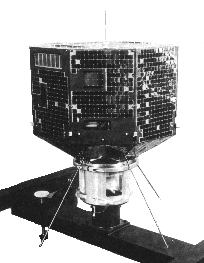|
|
Hakucho (CORSA-b)
 Full resolution image
Full resolution image
The Japanese CORSA-b, dedicated to X-ray astronomy, was launched
by the three stage rocket M-3C-4 from Kagoshima Space Center on 21
February 1979 into a semi-circular orbit with a apogee of 572 km,
a perigee of 545 km, an inclination of 29.9° and an orbital period
of 96 minutes.
Once on-orbit, the satellite was renamed Hakucho, which is Japanese for swan
or Cygnus. Hakucho was designed with the following objectives: a
complete sky survey looking for X-ray bursts, the spectral and temporal
study of sources, the monitoring of transient sources, the study of the
sky at sub-keV X-rays, and the observation of specific objects in
coordination with other instruments/at other wavelengths.
After a week of check-out the instruments were switched on on 27 February
1979. Hakucho operated for about two years simultaneously with
the Einstein observatory carring a payload complementary to that on board
Einstein. From 1983 operated also simultaneously with Tenma, the second
Japanese X-ray astronomy satellite. It re-entered on 16 Aprile 1985.
The satellite was an octagonal pillar with a tapered tail as shown
in the figure above. The satellite had a light weight. The total mass
was 95.9 kg where the X-ray instrumentation was about one-third
of the total. The satellite was spin stabilized, with a
nominal spin period of 12 seconds. There was a constraint due to the
Sun such that the angle between the spin axis and the solar direction
must have been maintained between 125° and 150°.
The X-ray detector system consisted of three experiments for a total of
elevent counters. Seven counters were placed on the top deck of the
spacecraft to observe sources in the sky region to which the spin axis
was pointed. Four counters, with fields of view perpendicular to the
spin axis, swept out bands of the sky as the satellite rotated.

- The Very Soft experiment (VSX) consisted in four identical counters
with a thin polypropylene window sensitive to 0.1 - 1.0 keV and
an effective area ~ 77 cm2 each. Two of counters (the P)
were located in a direction almost parallel to the spin axis at 2.7°
offset. The other two (the V) where located offset to the spin axis tilted
45°.
- The second experiment, Soft X-ray (SFX), consisted in 6
proportional counters
with a Be window sensitive to 1.5 - 30.0 keV.
Four of the counters (the P divided in two CMC and two FMC)
have a viewing direction parallel to the spin axis and the other
two (the V) were 45 ° tilted.
Two of the P counters, the CMC, have identical effective area (69 cm2)
and FOV 17.6°. The other two P counters, the FMC have an identical FOV of
5.8° FWHM and effective area of 40 and 83 cm2.
The V counters have identical effective area (32 cm2)
and FOV 50.3° X 1.7°.
- The last experiment the Hard X-ray (HDX) was a NaI (Tl) scintillation
counter sensitive to 10 - 100 keV. It consisted in only one unit
with an effective area of 49 cm2 and a FOV of 4.4° X 10.0°
FWHM. This detector was located parallel to the spin axis with a small
offset of 3°.
The instrument could be operated with different modes providing
different energy and time resolution (with 5.86 ms minimum).
Hakucho discovered a number of new X-ray burst sources, including Cen X-4
and Aql X-1. This linked bursters with low-mass optical counterparts that
had been previously identified. The satellite also monitored the
variabilities in known pulsars like A0535+262 and Vela X-1, showing
complicated variation of the pulse period.
Discovered a 2 Hz rapid variability from the Rapid Burster, known now
as Quasi Periodic Oscillation.
[Hakucho Home]
[About Hakucho]
[Gallery]
[Publications]
Page authors: Lorella Angelini Jesse Allen
HEASARC Home |
Observatories |
Archive |
Calibration |
Software |
Tools |
Students/Teachers/Public
Last modified: Wednesday, 22-Oct-2025 10:17:49 EDT
|
 Full resolution image
Full resolution image


